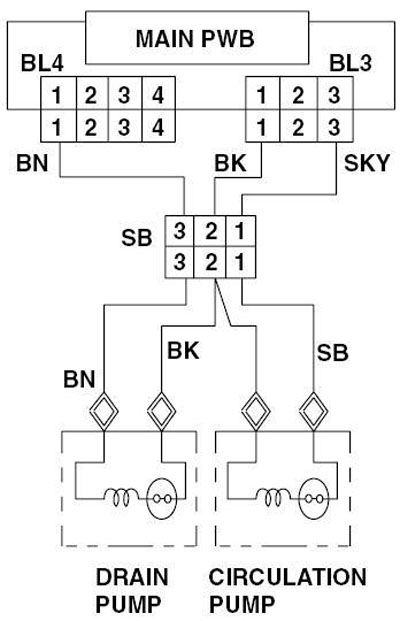
SB Circulation pump L1
BR Drain
BK POWER to the valves, pump motors, and door monitor
Color code:
SB Sky Blue (also SKY)
V Violet
BK Black
BN Brown
The drain pump and the circulating pump are attached to either side of the filter housing. The drain pump is used to remove the water from the washer. The recirculating pump serves three purposes: it sprays water from the tub onto the laundry to create a better saturation of detergent and better rinsing, it keeps the window clean, and it allows the customer to see water in the tub.
These pumps may fit physically in either position, but they should not be used interchangeably because the power input and flow rates differ.
You can identify the pumps by their output hoses. If there is only one pump, it is the drain pump. It has the larger output hose. The other pump (not present on base models) is the recirculation pump. It may have one or two smaller hoses which serve to put water on the window and spray water into the load during the wash and rinse cycles.
The filter between the pumps is not a lint filter in the traditional sense. It serves to trap larger objects (keys, coins, buttons, etc.) that may find their way into the washer and protects the pumps from physical damage. here is a small rubber hose attached to the pump housing that is used to drain the sump to eliminate spillage when cleaning the filter or servicing the machine.

|
The connections are shown on the main board. SB Circulation pump L1 BR Drain BK POWER to the valves, pump motors, and door monitor Color code: SB Sky Blue (also SKY) V Violet BK Black BN Brown |
Test Points for Pump Motor(s)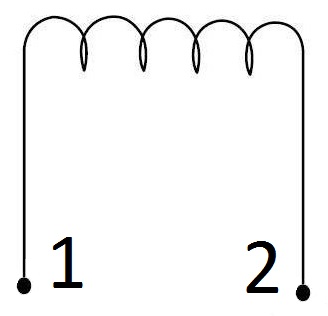 |
Test the resistance of the pump motor. Disconnect the pump from the circuit to test, either at the pump or at the connector on the main board. DRAIN PUMP (Left) 1 to 2 10 ~ 20 ohms CIRCULATION PUMP (Right) 1 to 2 18 ~ 30 ohms Not all machines include the circulation pump. In that case, the pump housing looks the same but the circulation site is blocked off. It is not possible to add the circulation pump to machines not so equipped from the factory because the wiring harness does not include a connection for it and the main board is not programmed to operate it. |
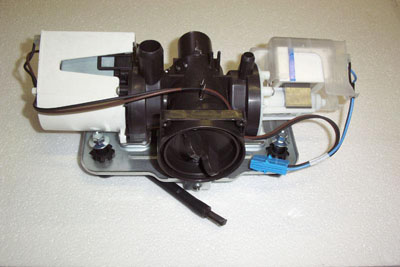 |
The pump motors can be tested from the connector on the control board or at the connection near the pump motor assembly in the base of the unit. Unplug the pump connector before testing the resistance. The pump motors are NOT interchangeable. They may fit physically, but the power requirements and outputs are different. |
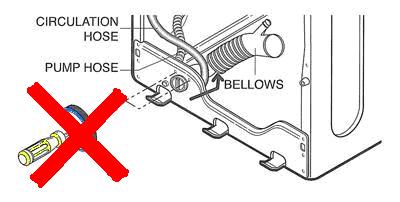 |
Remove the front cabinet. Drain the water from the sump. Remove the clamps and hoses. Since the pump sits on a platform assembly, no screws are used to attach it to the front of the machine frame. Older models had the pump attached directly to the base of the machine, using two screws to secure it to the fromt of the cabinet. |
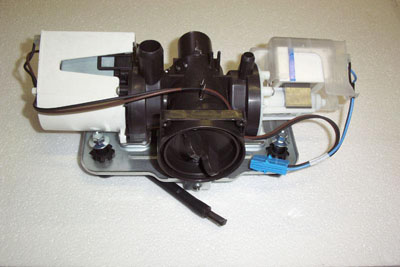 |
Both the drain pump (left) and the circulation pump (right) are mounted on the filter housing. The entire pump assembly is then mounted on a suspension plate base attached to the washer base by three antivibration bushings and 10 mm bolts. Use a socket and a short extension to remove the pump assembly. In older machines, the pump housing slides into a slot on the base of the machine and two screws secure it to the front of the machine base. To release the housing, you'll have to reach behind it blind and press the release tab. The small hose is to allow draining the sump before servicing the washer. |
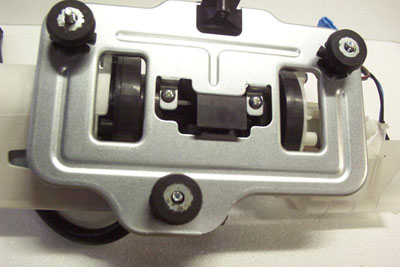 |
Bottom view of the pump and filter assembly, showing the antivibration bushings and bolts and the two screws that hold the pump assembly to the base. Removing the three large bolts allows the entire assembly to be tilted so either pump can be serviced without further disassembly. |
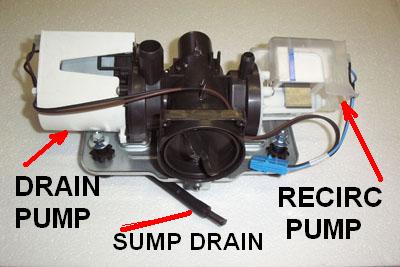 |
Pumps labeled. |
Questions? Comments! Concerns? Report an error? Let us know! An e-mail should solve the problem.